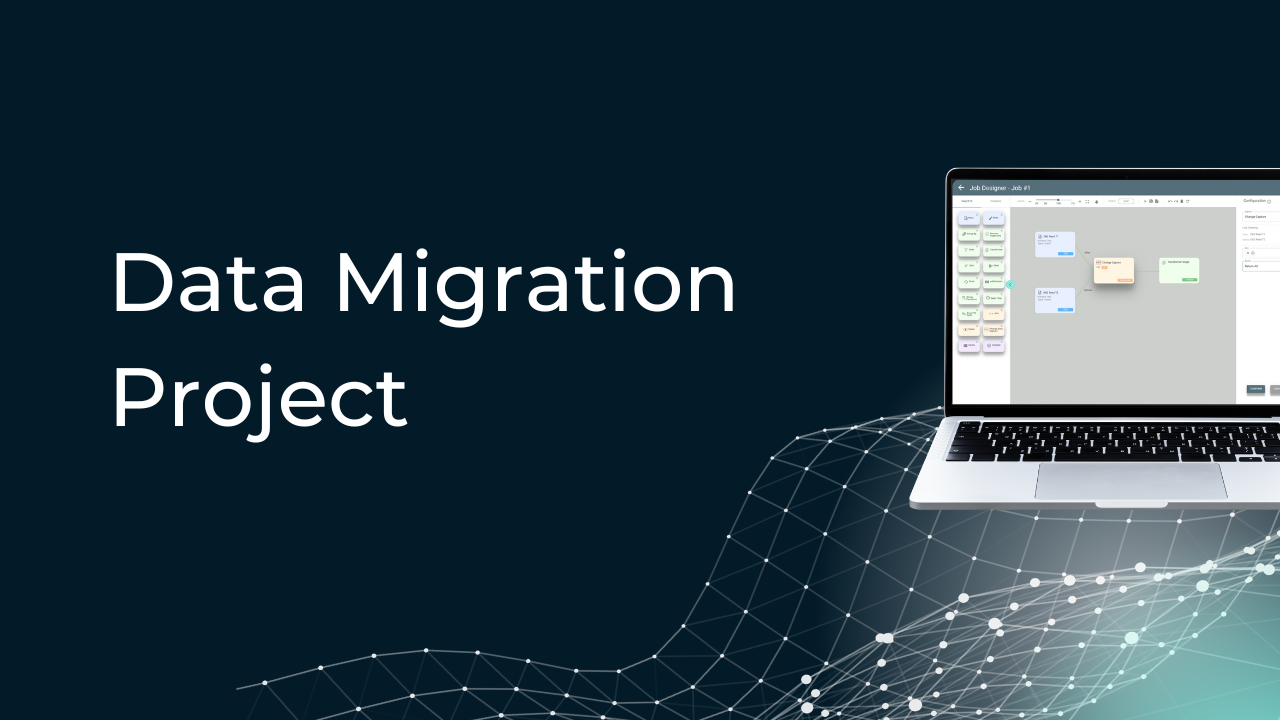
Table of Content:
Table of Content:


One of the first questions that come to mind when migrating data is, “How long does data migration take?”. There’s no uniform answer as the timeline is affected by multiple factors. In this guide, we’ll explore key factors that impact the duration of data migration.
What is Data Migration?
In simple terms, data migration is moving data from one system to another. Often, organizations have to transfer data when upgrading their software or hardware, consolidating databases, or switching to cloud-based storage.
Why does data migration matter? If your business relies on outdated software or scattered data, it could lead to slowdowns and inefficiencies. Data migration aims to keep everything organized, up-to-date, and accessible. It ensures accurate transfer of critical data — and thus reduces the risk of data loss and supports uninterrupted business operations.
Factors Influencing Data Migration Duration
Several factors influence how long the data migration process will take. Let’s explore each one to understand their impact better.
Volume of Data: How the Amount of Data Being Migrated Impacts the Timeline
The sheer volume of data being migrated is one of the most straightforward factors affecting the timeline. It’s like moving from a small apartment to a large house — more stuff means more time. Transferring everything precisely takes longer if you’re dealing with gigabytes or even terabytes of data.
Data Complexity: How Complex Data Structures and Formats can Lengthen the Process
While it’s simple to transfer simple text files, moving complex data structures with multiple relationships and dependencies is a different story. If your data has complex databases with multiple tables, foreign keys, and specific formats, the migration process will be more complicated and lengthy. Each piece must fit perfectly in the new system.
Source and Destination Systems: Compatibility and Configuration Differences Between Systems
Another serious factor is the compatibility between the source and destination systems. The process is relatively quick if the systems are similar or designed to work together. However, if they have different configurations or are built on different technologies, additional steps are typically required to ensure compatibility — converting data formats, reconfiguring system settings, etc. This adds extra time to the process.
Data Quality: How Data Cleansing and Validation Efforts Can Add Time
If the data being migrated is messy, incomplete, or inconsistent, extra time must be invested in data cleansing and validation. This means identifying and correcting errors, filling in missing information, and ensuring that the data is accurate and reliable.
Network Speed: Impact of Network Bandwidth and Latency on Data Transfer Speeds
Faster data transfer is possible with higher network bandwidth, while lower bandwidth or high latency slow things down. If you’re migrating data over the internet, take into account factors like your connection speed and network congestion.
Migration Tools and Methods: Different Tools and Methods (e.g., Batch Processing vs. Real-time Migration) and Their Effects on Time
Finally, the tools and methods you choose for data migration impact the timeline. Batch processing, where data is moved in large chunks, is efficient but requires downtime. Real-time migration, on the other hand, permits continuous data transfer with minimal disruption but has a longer overall duration.

Steps in the Data Migration Process
Migrating data is not as difficult as it appears on the surface. All you have to do is follow five essential steps, which are described below.
Planning and Assessment: Time Spent on Initial Planning and Assessing Data
This phase sets the stage for everything that follows, so it’s worth investing the time to get it right. This is how you can do it:
- Identify data format, location, and sensitivity. Is it structured or not? Where is it currently stored? How sensitive is the information? These details will aid you in laying out the entire migration process.
- Plan project size and scope. What do you want to achieve with this migration? Set realistic timelines and figure out what resources you’ll need.
- Backup all data to prevent any data loss during the migration.
- Evaluate your team’s capabilities and the tools at your disposal. Do you have the right people and technology to execute this migration? If not, now is the time to address those gaps.
This is how you will create a strong foundation for a successful migration and make the subsequent phases more predictable.
Designing the Migration: Creating a Detailed Migration Plan
Designing your migration plan is where you lay out the blueprint for the overall process:
- The tools you choose can make or break your migration. Research and test different options, such as AWS Data Migration Service (DMS), Azure Database Migration Service, Databricks for ETL, Talend, Informatica PowerCenter, IBM InfoSphere DataStage, Microsoft SQL Server Integration Services (SSIS), Apache NiFi, etc.
- Define the migration method. Will you be moving everything at once or in phases? This is where you decide on the approach. Some common data migration methods include Big Bang, trickle, parallel, hybrid, cloud-based migration, and database replication. Choose based on your data’s complexity and your organization’s tolerance for downtime.
- No plan is foolproof, so identify potential risks and have contingency plans in place, including backup strategies, rollback plans, and identifying key personnel to troubleshoot possible issues.
- Break down the migration into smaller tasks with clear milestones. This helps in tracking progress and makes it easier to spot and address issues early on.
- Assign specific roles and responsibilities to team members. Make sure everyone knows what they’re responsible for and who to turn to for help.
- Establish a communication plan that keeps all stakeholders informed and provides a platform for addressing concerns.
Also, you can reach out to a dedicated data migration service to turn a chaotic process into a structured and manageable project.
Testing: The Importance of Running Tests and How This Phase Can Vary in Duration
Testing ensures that your data migration is error-free, maintains data integrity, and runs as expected. The risk of costly mistakes is high if you skip or rush through this phase, so it’s crucial to take your time to get it right.
Types of tests include:
- Unit tests. They involve testing small sections of data or specific functionalities separately.
- System tests. They assess the entire system as a whole to guarantee seamless integration and interaction between components.
- User acceptance tests (UAT). UAT involves real users testing the system in a controlled environment to ensure it meets their expectations.
The duration of the testing phase is dependent on the complexity and volume of data, the thoroughness needed, and the available resources. Generally, if your data migration is moderately complex, expect the testing phase to take 4-8 weeks. In case of more complex migrations, it can last for 3-6 months or more.

Execution: Actual Data Transfer Process
This is the climax of your meticulous planning and rigorous testing.
Here are the key steps:
- Preparation. Confirm that everything is ready and stakeholders are informed. Make sure there is a recent backup to restore data if necessary. Let all parties know about the migration timeline and expected downtime.
- Execution. Begin the data migration with the method you chose. Using monitoring tools to track progress and detect issues, be prepared to troubleshoot any errors or performance issues as soon as possible.
- Validation. Check that the data volumes and key elements are consistent between the source and target systems. Conduct thorough checks to confirm data accuracy and prevent corruption. Ensure that the new system operates correctly with the migrated data.
Remember that successful migration requires precision, real-time monitoring, and prompt issue resolution.
Post-Migration Activities: Validation, Testing in the New Environment, and Resolving Issues
The work doesn’t end once the data has been moved. To ensure proper functioning, post-migration activities are necessary. Verify that all data was transferred precisely, test it in the new environment to ensure it performs as expected, and address any issues that come up. Monitor the new system constantly for any signs of trouble and use automated tools to track system performance, data integrity, and user activity. Establish a feedback system with end-users and stakeholders and provide continuous support to quickly address any post-migration problems.
Best Practices to Minimize Migration Time
These tips will help you shorten the time needed for data migration.
- Create clear objectives and deadlines for the migration process to keep the project on schedule and ensure everyone comprehends their roles and responsibilities.
- Create a step-by-step plan that outlines each phase of the migration, including preparation, execution, and validation. Consider potential risks and develop contingency plans to address them.
- Use automated migration tools to handle repetitive and complex tasks. They speed up the process and lessen the chance of human error.
- Instead of migrating data sequentially, use parallel processing to transfer multiple data sets simultaneously.
- Spreading the workload evenly among multiple servers will prevent bottlenecks and expedite the migration process.
- Perform pilot migrations to spot and resolve any potential issues before the actual migration.
- Make sure your data is clean and standardized before migration to prevent transferring redundant or corrupted data.
- Prioritize the migration of critical data first. Essential operations will still be carried out even if the migration process takes longer than anticipated.
- Keep all stakeholders informed about the migration plan, progress, and any potential impacts on business operations.
- If the overall data migration process seems too complicated, you can always ask for a professional ETL consultant‘s assistance.
Also, have a dedicated team ready to address any problems that arise during the migration. Quick response times are important for keeping the migration on schedule.
Now that you know everything about minimizing migration time, it’s time to answer the main question — “How long does migration take?” For smaller projects involving less complex data and fewer records, the migration takes a few days to a couple of weeks. If there are moderately complex migrations with a larger volume of data, the process takes anywhere from a few weeks to a couple of months. Finally, large migrations involving significant data volumes and intricate dependencies take up from several months to over a year.








Contact us






















































